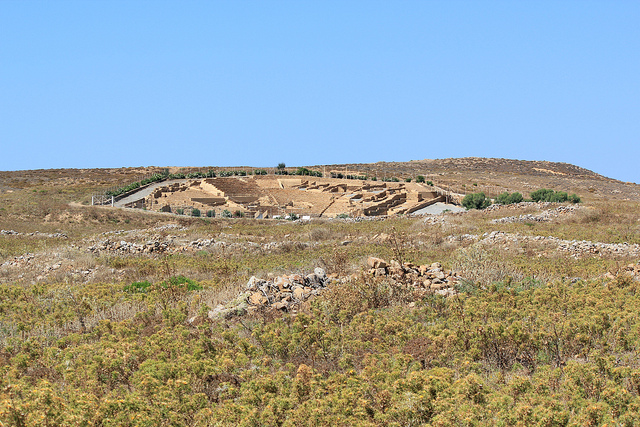Galen (a prominent Roman of Greek ethnicity, physician, surgeon and philosopher), during his transition to Lemnos, expressed his admiration for it, because in this island there was not only one city, which was the case in the rest areas of the Aegean Sea, but it had two.
More specifically there was Myrina in the west and Hephaestia in the east. One of the most famous epithets of Lemnos is "Dipolis", the island with the two powerful cities during the time of the Athenian domination, Myrina and Hephaestia.
Hephaestia was the capital of the Pelasgians, in the north-east side of the island, near today's village Kontopouli. Its life lasted from 1000 BC until 1200 AD, while it flourished especially during the 5th and 4th century BC. There are ancient ruins of a complex city in an area of almost 10 layers, which included splendid buildings, palaces, baths, Christian churches, an Hellenistic-Roman theatre and an 8th to 6th century BC Sanctuary, dedicated to the Great Goddess Lemnos, who is identified to Goddess Artemis. In the continuous rooms of the Sanctuary, remarkable works of art have been discovered, like an entire line of stoneware statues depicting Sirens and sphinxes. The Necropolis of Hephaestia and findings were discovered at the south-west of the city, and next to it three cemeteries of subsequent times.
Hephaestia was set on fire by the Persians in 511 BC but it was built again by the Athenians, it gained strong walls and it maintained its role as the capital or co-capital of the island until the Middle Ages. It was the economic centre of the island until the 11th century AD, when its harbor was gradually embanked and the establishment of the Venetians in neighboring Kotzino begun.
More specifically there was Myrina in the west and Hephaestia in the east. One of the most famous epithets of Lemnos is "Dipolis", the island with the two powerful cities during the time of the Athenian domination, Myrina and Hephaestia.
Hephaestia was the capital of the Pelasgians, in the north-east side of the island, near today's village Kontopouli. Its life lasted from 1000 BC until 1200 AD, while it flourished especially during the 5th and 4th century BC. There are ancient ruins of a complex city in an area of almost 10 layers, which included splendid buildings, palaces, baths, Christian churches, an Hellenistic-Roman theatre and an 8th to 6th century BC Sanctuary, dedicated to the Great Goddess Lemnos, who is identified to Goddess Artemis. In the continuous rooms of the Sanctuary, remarkable works of art have been discovered, like an entire line of stoneware statues depicting Sirens and sphinxes. The Necropolis of Hephaestia and findings were discovered at the south-west of the city, and next to it three cemeteries of subsequent times.
Hephaestia was set on fire by the Persians in 511 BC but it was built again by the Athenians, it gained strong walls and it maintained its role as the capital or co-capital of the island until the Middle Ages. It was the economic centre of the island until the 11th century AD, when its harbor was gradually embanked and the establishment of the Venetians in neighboring Kotzino begun.


